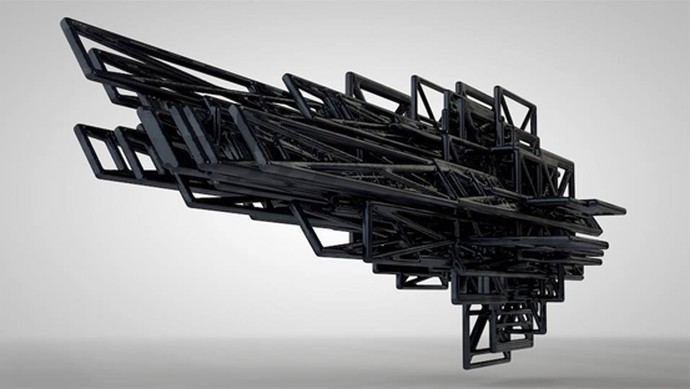
Interstellar Hackers (left to right): Oz Monroe, Damion Waltermeyer, Philippe Lewis, Mike Mongo, Rachel Armstrong, Damien Turchi and Jerard Puckett.
When we start to examine the principles and details of the kinds of structures and infrastructures that may enable us to inhabit new solar systems – what exactly are engineering and we designing?
At first, this might seem like a fatuous question.
From the outset, a starship has been imagined as a vessel that transports matter from one place to another. For example, Robert H. Goddard first proposed the idea of space arks in 1918 when he wrote The Last Migration, envisaging the need for an “interstellar ark” the help humanity avoid escape the death of the Sun. The sleeping crew would awaken centuries later to find themselves in another star system. This sleeper ship concept is different to a generational starship, or worldship, that carries its own environment. In 1928 Konstantin E. Tsiolkovsky first described such artificial worlds in The Future of Earth and Mankind, where he described a space colony that traveled for centuries through space on a vessel called “Noah’s Ark”.
Yet, in an age of robotically operated probes and advanced communications system, what exactly is being ‘transported’? Can for example, the relay of digital signals to earth by the British Interplanetary Society’s Daedalus be regarded as coming from something that counts as a starship?
When we look deeper into the thinking behind our thinking – or the philosophy – of the way we approach the interstellar question (will humankind one day settle solar systems beyond our own), the answers to these challenges are very complex. Their purpose, meaning and design do not lie in the thing itself, but in our framing and understanding of the question – what is a starship?
Our workshop at the Interstellar Hackathon took three different perspectives from which a range of different kinds of starship could be proposed and developed. Namely:
THREE DEFINITIONS OF A STARSHIP
ANTHROPOCENTRIC PERSPECTIVE, that concentrates on human only agendas;
ECOLOGICAL PERSPECTIVE, that acknowledges other species and the infrastructures for surviving and thriving in worlds beyond our own;
COSMIC PERSPECTIVE, in which our starships are simply instruments through which the universe is starting to observe itself.
By challenging our fundamental assumptions about what we are doing, we not only develop a greater understanding of what we are collectively proposing to achieve but also open up new conversations with each other, which establish the foundations of what we can call ‘an interstellar culture’.
Frederik de Wilde’s StarshipSPIDER
 (c) Concept Design Frederik de Wilde
(c) Concept Design Frederik de Wilde
Frederik de Wilde’s starshipSPIDER is a concept craft that is more than an inert hull moving through interstellar space. It is a body that talks about the construction of interstellar space, its Spartan ecology and the strangeness of matter. It’s absolute blackness links matter with the abyss. It spins its own scaffolding that it uses as a locomotory system to infiltrate unknown territories. As it’s multiple, intersecting carbon planes voyage through the ‘ emptiness of space, it weaves threads formed by photonic winds and buckyballs. Tirelessly constructing cosmic theatres between galaxies the starshipSPIDER’s web snares epic vagrant celestial bodies that invent narratives and strange events as they shake and struggle in its dark cosmic web. Vibrations from these performances resonate throughout the universe fusing with primal notes from its background noise.
StarshipSPIDER is pitilessly black. Its artistic roots arising deep within the satanic mills of the industrial revolution that spewed black carbon into Earth’s atmosphere and marked the urban environment with its dark scars as an absolute rejection of the depiction of objects in favor of pure expression, evoking moods that ranged from joy to chaos.
In an interstellar context StarshipSPIDER yearns for kinship with both the visible and dark universes generating scaffoldings that communicate between these incompatible realms and in doing so synthesizes an unlikely, restless space ecology.
The concepts underpinning StarshipSPIDER are a very long way from being buildable however, the elegance of the project emphasizes the idea of space as an inhabited ecology in which a range of epic nonhuman inhabitants dwell. It reminds us of the primitive status of our own legacy of space exploration with our clumsy, industrial hulls and trails of pollution and asks us to think again about our future relationship with the fabric of space and the assumption that it is not alive.